
State Electricity Commission of Victoria
Encyclopedia

Victoria (Australia)
Victoria is the second most populous state in Australia. Geographically the smallest mainland state, Victoria is bordered by New South Wales, South Australia, and Tasmania on Boundary Islet to the north, west and south respectively....
, Australia
Australia
Australia , officially the Commonwealth of Australia, is a country in the Southern Hemisphere comprising the mainland of the Australian continent, the island of Tasmania, and numerous smaller islands in the Indian and Pacific Oceans. It is the world's sixth-largest country by total area...
. Control of the SECV was by a board of Commissioners appointed by the Victorian Government, following the example of the Victorian Railways
Victorian Railways
The Victorian Railways operated railways in the Australian state of Victoria from 1859 to 1983. The first railways in Victoria were private companies, but when these companies failed or defaulted, the Victorian Railways was established to take over their operations...
, and in contrast to the Departmental control that managed Australian postal and telephone services.
Background

Trams in Australia
Trams in Australia are now used extensively as public transport only in Melbourne, and to a lesser extent, Adelaide and Bendigo while Sydney operates a modern light rail system. Several other major cities had tram networks however these networks were largely dismantled during the 1950s and some as...
. As a result electricity generation and distribution tended to be carried out by municipalities, by private companies under franchise to the councils, or by joint private-public bodies.
Prior to the establishment of SECV, electricity was generated and distributed by a number of private and municipal generator and distribution companies. The main municipal-owned power station in Victoria was operated by the Melbourne City Council
City of Melbourne
The City of Melbourne is a Local Government Area in Victoria, Australia, located in the central city area of Melbourne. The city has an area of 36 square kilometres and has an estimated population of 93,105 people. The city's motto is "Vires acquirit eundo" which means "She gathers strength as she...
, who generated electricity from its Spencer Street Power Station
Spencer Street Power Station, Victoria
Spencer Street Power Station was a Victorian era coal-fired power station which operated on Spencer Street in central Melbourne, Victoria, Australia. Opened in 1892, it was closed in 1982 after being deemed an eyesore, and in 2006 demolition commenced....
for the city’s residents, as well as being a wholesale supplier to other municipal distributors. The main privately owned company was the Melbourne Electric Supply Company which was established in the 1880s and operated under franchise arrangements with a number of other municipal distributors. The final major generator of electricity was the Victorian Railways
Victorian Railways
The Victorian Railways operated railways in the Australian state of Victoria from 1859 to 1983. The first railways in Victoria were private companies, but when these companies failed or defaulted, the Victorian Railways was established to take over their operations...
who operated the Newport Power Station
Newport Power Station, Victoria
The Newport Power Station is a complex of power stations in the suburb of Newport, Melbourne, Victoria, Australia. Newport A, B, and C coal-fired plants operated at the site between 1918 and the 1970s, while the Newport D 500 MW gas-fired peak load plant has operated since 1981.-Newport A, B, and...
, for the supply of electricity to Melbourne's suburban trains
Railways in Melbourne
The Melbourne rail network is operated by Metro Trains Melbourne under franchise from the Government of Victoria. The network is based on a commuter rail model centred on the Melbourne Central Business District and Flinders Street Station, rather than a rapid transit model, with a focus on...
. These early generators all relied on a fuel supply provided by the strike prone black coal industry of New South Wales.
Formation
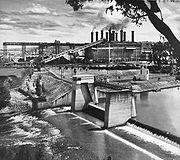
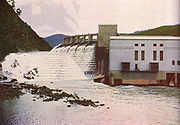
Latrobe Valley
The Latrobe Valley is an inland geographical region and urban area of Gippsland in the state of Victoria, Australia. It is east of the City Of Melbourne and nestled between the Strzelecki Ranges to the south and the Great Dividing Range to the north – with the highest peak to the north of the...
, located to the east of Melbourne. Brown coal has a low energy density due to the high moisture content and would have been uneconomic to transport into Melbourne, but advances in electrical transmission technology meant that electricity could be generated beside the fuel source and transmitted to the consumer.
The Victorian Government established a Brown Coal Advisory Committee which reported in September 1917. It recommended the establishment of an Electricity Commission to develop the brown coal reserves and construct a power station and transmission lines. In December 1918, a Bill was passed to establish a Commission with both regulatory and investigative powers, including taking over the enforcement of the existing Electric Light and Power Act, which regulated all electricity generators and distributors.
Legislation passed in December 1920 resulted in the formation of the SECV from the Electricity Commission, with Sir John Monash
John Monash
General Sir John Monash GCMG, KCB, VD was a civil engineer who became the Australian military commander in the First World War. He commanded the 13th Infantry Brigade before the War and then became commander of the 4th Brigade in Egypt shortly after the outbreak of the War with whom he took part...
both chairman and General Manager. Funds were also available to the SECV for the development of the works recommended in 1917. The legislation also gave the SECV the authority to decide whether rival organisations could be set up in competition to it, as well as the authority to take over existing private companies when their franchises expired.
The SECV took over a number of small municipal electricity distributors during the 1920s, and in the 1930s the Melbourne Electric Supply Company was acquired along with their street tramway operations. Despite these acquisitions, municipal controlled distribution companies known as Municipal Electricity Undertakings (MEUs) in the inner urban areas of Melbourne remained outside of SECV control until the privatisation of the industry in the 1990s.
The first capital works to be carried out by the SECV was the development of the Yallourn Power Station
Yallourn Power Station, Victoria
Yallourn Power Station was a complex of six brown coal fuelled power stations built progressively from the 1920s to the 1960s. Located in Victoria's Latrobe Valley, the complex was situated beside the Latrobe River, with the company town of Yallourn located to the south west...
, briquette factory, and open-cut brown coal mine in the Latrobe Valley. Expansion was also carried out at the Newport Power Station
Newport Power Station, Victoria
The Newport Power Station is a complex of power stations in the suburb of Newport, Melbourne, Victoria, Australia. Newport A, B, and C coal-fired plants operated at the site between 1918 and the 1970s, while the Newport D 500 MW gas-fired peak load plant has operated since 1981.-Newport A, B, and...
which was fuelled by imported black coal and Yallourn briquettes. Work on hydroelectric power also commenced with the Rubicon Hydroelectric Scheme
Rubicon Hydroelectric Scheme
The Rubicon Hydroelectric Scheme is located on the Rubicon and Royston Rivers, north east of Melbourne, 40 km south-west of Alexandra, Victoria, Australia. The scheme commenced in 1922, and was the first state-owned hydroelectric scheme to generate electricity in mainland Australia, and among...
to the north-east of Melbourne.
Electricity pricing was set by the SECV and had different tariffs for towns of different size, dependant on the costs of providing the electricity supply. Country interests argued that this was unfair to rural consumers, and in June 1928 a conference of rural and regional councils demanded the government equalise of tariffs, but was rejected by the Labor Government. Equalisation of tariffs was not brought in until 1965, and it was due to the SECV itself rather than a response to political pressures.
Growth

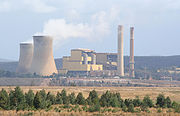
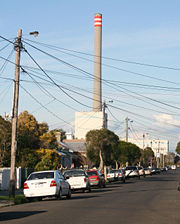
Kiewa Hydroelectric Scheme
The Kiewa Hydroelectric Scheme is the largest hydro-electric scheme in Victoria and the second largest in mainland Australia after the Snowy Mountains Scheme...
also saw continued development. The Richmond Power Station
Richmond Power Station, Victoria
Richmond Power Station is a Victorian era coal fired power station which operated on the banks of the Yarra River in Richmond, Victoria, Australia from its construction in 1891 until its closure in 1976. It was one of the first alternating current electricity generation plants in the state...
was also converted to oil firing, and smaller 'prefabricated' power stations were erected in Geelong
Geelong Power Station, Victoria
The city of Geelong, Victoria, Australia was once home to two coal fueled power stations - Geelong A and Geelong B.The first moves to providing an electricity supply to Geelong were made in 1898, with three separate companies vying for the right to operate in the city...
and Ballarat. These addition resulted in a reduction in the dependence on black coal by the 1950s.
By the 1960s the trend towards more efficient large capacity equipment continued, with additional generators of 120 MW capacity installed at Yallourn, and the Hazelwood Power Station
Hazelwood Power Station, Victoria
Hazelwood Power Station, in the Latrobe Valley, Victoria, Australia is a brown coal fueled base-load power station built between 1964 and 1971. The power station is of 1,600 megawatt capacity, and supplies up to 25% of Victoria's base load electricity and more than 5% of Australia's total energy...
with eight 200 MW units commissioned along with a new open cut mine and briquette factory. The Hazelwood mines was not as successful as planned as Morwell coal was unsuitable for making briquettes, resulting in coal needing to be railed from the Yallourn mine.
By the end of the decade brown coal was used to generate 90 per cent of Victoria's electricity supply, with all of the coal sourced from open cut mines under SECV control. As a result the SECV was not forced to raise power costs during the 1970s oil price shocks, in contrast to other electricity supplier around the world.
Expansion in the Latrobe Valley continued though the 1970s with the Yallourn W plant replacing the older units and delivering much greater reliability with Japanese and German technology, compared to the previously utilised equipment from the UK. A new gas fuelled power station was also proposed in the early 1970s for Newport to replace existing plant, but met considerable opposition from nearby residents becoming the first major SECV project that met widespread opposition from the general public. It was not opened until the 1980s and with only half the proposed capacity.
In the 1980s work on a third open cut commenced at Loy Yang, as the Yallourn and Morwell coal fields were both committed to fuel existing power stations. The plan was for two new stations (Loy Yang A and B
Loy Yang Power Station, Victoria
Loy Yang Power Station is a brown coal fired power station located on the outskirts of the city of Traralgon, in south eastern Victoria, Australia. Loy Yang is a base load supply station, and produces about one third of Victoria's electricity requirements...
) consisting all a total of eight 500 MW units, all fed by the common coal mine. The project was hit by cost overruns, with an independent review initiated by the government in late 1982, finding excessive rates of pay for construction and operation staff, poor project management, over investment in both the coal mine and power station and general overmanning.
Electricity costs to consumers also begun to rise in the 1980s, due to the need to pay greater dividends to the Victorian Government and to service greater debt levels from the heavy expansion. The SECV was also a part to the Portland Smelter Contract
Portland aluminium smelter
The Portland aluminium smelter is located atPortland, Victoria, Australia.The smelter has a production capacity of 345,000 tonnes of aluminium per yearThe smelter is a joint venture owned by...
, which provided the Alcoa aluminium smelter with favourable electricity prices at the expense of other consumers.
Demise
In 1994, the KennettJeff Kennett
Jeffrey Gibb Kennett AC , a former Australian politician, was the Premier of Victoria between 1992 and 1999. He is currently the President of Hawthorn Football Club. He is the founding Chairman of beyondblue, a national depression initiative.- Early life :Kennett was born in Melbourne on 2 March...
government disaggregated the SECV into five distribution and retail companies (absorbing the MEUs in the process), five generation companies, and a transmission company. Along with other state-owned utilities (such as the Gas and Fuel Corporation of Victoria
Gas and fuel corporation of victoria
The Gas and Fuel Corporation of Victoria was a government-owned monopoly supplier of household gas in Victoria, Australia.In 1951, the Victorian government took over two of the three main gas utilities in Melbourne - the Metropolitan Gas Company and the Brighton Gas Company...
), these businesses were all corporatised, then privatised between 1995 and 1999.
The only entities remaining in State Government ownership was the wholesale market operator Victorian Power Exchange
Victorian Power Exchange
The Victorian Power Exchange was established in 1995 by the Government of Victoria as part of a restructuring of the State Electricity Commission of Victoria and the establishment of a competitive electricity market....
(VPX) and the SECV shell which holds indentures for debts owed to it by brown coal development company HRL Limited,, and pays Alcoa annual subsidies for its significant electricity needs. VPX was subsequently reorganised with its market and system operation functions being transferred to the National Electricity Market Management Company (NEMMCO
NEMMCO
The National Electricity Market Management Company Limited was the Wholesale Market and Power System Operator for the Australian National Electricity Market...
) and its transmission planning functions being transferred to VENCorp
VENCorp
VENCorp was responsible for the efficient operation of gas and electricity industries in Victoria, Australia. VENCorp, which was established in December 1997, was a Victorian State Government-owned entity within Victoria's privatised energy industries...
.
Currently, the Essential Services Commission of Victoria
Essential Services Commission (Victoria)
The Essential Services Commission is the economic regulator established by the State Government of Victoria, Australia to regulate prescribed essential utility services supplied by the electricity, gas, water, ports, grain handling and rail freight industries and aspects of the insurance industry...
is responsible for the regulation retail businesses and the Australian Energy Regulator
Australian Energy Regulator
The Australian Energy Regulator is the regulator of the wholesale electricity and gas markets in Australia. It is part of the Australian Competition and Consumer Commission and enforces the rules established by the Australian Energy Market Commission....
is responsible for regulating distribution, transmission and the wholesale electricity market.
Other responsibilities
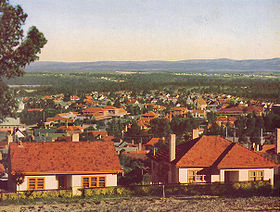
- Built and managed the company townCompany townA company town is a town or city in which much or all real estate, buildings , utilities, hospitals, small businesses such as grocery stores and gas stations, and other necessities or luxuries of life within its borders are owned by a single company...
of YallournYallourn, VictoriaYallourn, Victoria was a company town in Victoria, Australia built between the 1920s and 1950s to house employees of the State Electricity Commission of Victoria, who operated the nearby Yallourn Power Station complex. However, expansion of the adjacent open-cut brown coal mine led to the closure...
for workers of the accompanying power station. - Produced briquetteBriquetteA briquette is a block of flammable matter used as fuel to start and maintain a fire. Common types of briquettes are charcoal briquettes and biomass briquettes.-Constituents of charcoal briquettes:...
s at Yallourn and Morwell from brown coal. - Operated a 900mm gauge electric railway at YallournYallourn 900mm RailwayThe Yallourn 900mm Railway was a 900 mm narrow gauge railway operated by the State Electricity Commission of Victoria in the Latrobe Valley of Victoria, Australia. The railway was built for the haulage of brown coal and overburden between the Yallourn open cut mine, briquette works, and power station...
to convey coal from the open cut, later extended to Morwell and Hazelwood. - Operated six diesel shunting locomotives identical to the Victorian RailwaysVictorian RailwaysThe Victorian Railways operated railways in the Australian state of Victoria from 1859 to 1983. The first railways in Victoria were private companies, but when these companies failed or defaulted, the Victorian Railways was established to take over their operations...
F class for shunting the Yallourn, Morwell and Newport Powerhouse rail sidings. - Operated and expanded the three provincial electric tramways in Ballarat, Bendigo and Geelong, after taking over the previous electricity-generating companies (the ESCo (Electric Supply Company of Victoria Ltd) and MESC (Melbourne Electric Supply Company)).
See also
- AGLAustralian Gas Light CompanyThe Australian Gas Light Company was an Australian gas and electricity retailer. It was formed in Sydney in 1837, and supplied town gas for the first public lighting of a street lamp in Sydney in 1841 AGL was the second company to list on the Australian Stock Exchange. The company gradually...
- Citipower
- NEMMCONEMMCOThe National Electricity Market Management Company Limited was the Wholesale Market and Power System Operator for the Australian National Electricity Market...
- PowercorPowercorPowercor is an electricity distribution company that operates throughout western Victoria and the western and southern suburbs of Melbourne....
- SP AusNet
- AlintaAlintaAlinta is an Australian energy infrastructure company. It has grown from a small, Western Australia based gas distributor and retailer to the largest energy infrastructure company in Australia. It was bought in 2007 by a consortium including Singapore Power and various now defunct Babcock & Brown...
- TRUenergyTRUenergyTRUenergy is an energy company headquartered in Melbourne, Victoria, Australia.Founded in 1995 as a retailer and generator of electricity, and a retailer of natural gas, the company is formed from the combination of retail and generation assets purchased by Hong Kong-based CLP from Singapore Power...
- VENCorpVENCorpVENCorp was responsible for the efficient operation of gas and electricity industries in Victoria, Australia. VENCorp, which was established in December 1997, was a Victorian State Government-owned entity within Victoria's privatised energy industries...
- VicPower Trading

